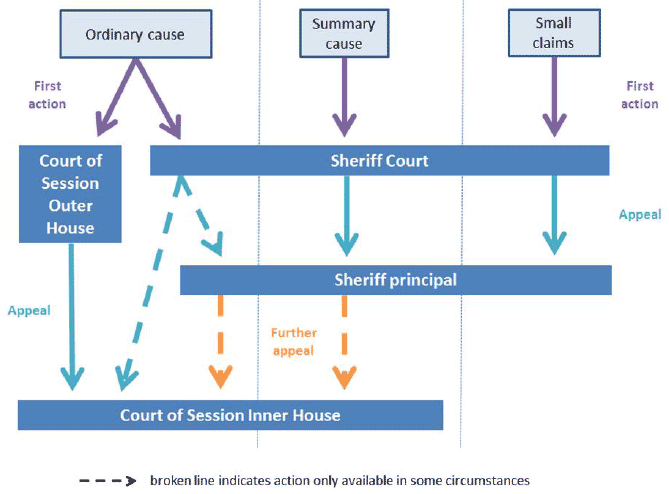Civil justice statistics in Scotland: 2014-2015
The 2014-15 Civil Justice in Scotland release includes: 1. MAIN STATISTICS TABLES (compromising tables that appear in this bulletin) 2. DIVORCE & DISSOLUTION STATISTICS TABLES (further breakdowns on divorce & dissolution) 3. SUPPLEMENTARY STATISTICS TABLES (additional statistics on civil law cases in sheriff courts and the Court of Session) 4. BACKGROUND DATA TABLES (an interactive dataset on civil law court cases by court, that can be used to generate user customised tables and charts)
This document is part of a collection
2. Introduction
Civil justice is concerned with the rights and obligations of people and organisations. One way of resolving civil law disputes between people and organisations is for a case to be brought to court. In Scotland, civil law cases are usually conducted in a sheriff court or the Court of Session. Common types of cases where civil law is used include debt, divorce and claims for personal injury.
Most civil law court cases involve disputes between people or organisations and are heard in a sheriff court or the Court of Session. Civil law court cases are carried out using one of three procedures: Ordinary cause, Summary cause or small claims. Sheriff courts also handle summary applications which are made mainly under statutes (Acts of Parliament) and commissary business relating to succession and access to a deceased person's estate. The relationships between the main civil law court procedures and the civil courts are shown in Figure 1, though it should be noted that there may be differences in certain circumstances. The court structure in Scotland and changes to the procedures introduced by the Courts Reform (Scotland) Act 2014 are described in more detail in section 12.
Figure 1: Summary of court structure

This bulletin presents and describes statistics on civil justice in Scotland. The primary focus is on civil law cases in sheriff courts and the Court of Session in the financial year 2014-15. This is supported by an overview of the civil court structure, a description of recent changes in legislation, a historical overview of the volume of civil law cases and a list of definitions. An overview of civil justice statistics from the Scottish Legal Aid Board and the Scottish Crime and Justice Survey add further context.
Civil law statistics are used within the Scottish Government to inform decision and policy making and to monitor the impacts of policies following implementation. The statistics are also used in resource allocation by the Scottish Courts and Tribunals Service and to support third sector activity in lobbying and funding applications. The statistics also inform the public about the business of Scottish courts and facilitate academic research on civil law.
In addition to this bulletin, the 2014-15 Civil Justice Statistics in Scotland release includes:
- main statistics tables - comprising the tables that appear in this bulletin
- divorce and dissolution statistics tables - giving further breakdowns on divorce and dissolution
- supplementary statistics tables - additional statistics on civil law cases in sheriff courts and the Court of Session
- background data tables - an interactive dataset on civil law court cases by court, that can be used to generate user customised tables and charts
- statistics news release
Civil Justice Statistics in Scotland 2014-15 builds on the improvements made in previous editions of this series. Statistics on judicial review are now included in this bulletin and can be found in the section titled Recent trends in civil justice section and in Table 23. These statistics were previously only available in the supplementary tables. Secondly, readability of the bulletin has been improved by moving the statistics tables to their own section towards the back of the bulletin. Finally, specific sections have been created for statistics on repossession and eviction to reinforce the distinction between these two case types.
Important notes on the use of civil justice statistics
The civil law court statistics published here relate only to the principal crave of cases. An individual case can involve a number of different case types. The case type which is listed first on the writ is normally known as the principal crave and the others are described as ancillary craves. The feasibility of publication of statistics on ancillary craves is being investigated.
The large variety of case types and procedural outcomes that can be pursued in civil law mean that recording and reporting civil law court cases accurately and reliably is a challenge. One consequence is that the number of ordinary cause and summary application cases disposed of in the sheriff court is an underestimate. There is no evidence of any significant inaccuracies in the data for summary cause and small claim cases. More information about accuracy of the statistics and further guidance on use of the statistics is available from the Quality of the statistics section.
The statistics in the tables for initiations and disposals do not necessarily refer to the same cases. This is because not all the cases initiated in a year will be disposed in that same year.
All statistics in this release are presented for financial years (1 April to 31 March) except where otherwise stated.
Contact
Email: Eddie Chan
There is a problem
Thanks for your feedback